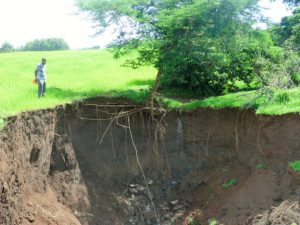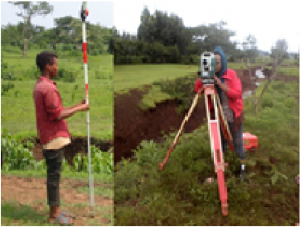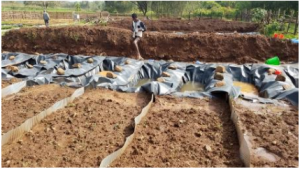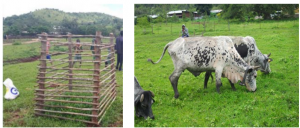#Soil Erosion #Sustainable Land Management
Project Summary
The research project aims to develop a Sustainable Land Management (SLM) framework for Ethiopia to help feed its rising population at the same time improving soil erosion management

Degradation of natural resources (land, water, and vegetation) is the biggest environmental problem in Ethiopia; and it is land degradation which is the most alarming.
Within sub-Saharan Africa, Ethiopia is considered one of the countries seriously affected by land degradation, the main culprit of which is soil erosion. Currently, it is estimated that about 300,000 hectares suffer annually due to soil erosion. In addition, some 1.5 billion tons of soil are being eroded all over the country at the same rate. If such huge soil losses continue unabated, Ethiopian Highlands could lose nearly all of its top soil in about 100 years.
The causes are multifaceted: use of traditional methods of cultivation, limited Sustainable Land Management (SLM) technology choice, historical and changing patterns of land ownership, and low levels of investment in agriculture and animal husbandry. The degrading effect of these human-induced causes is further exacerbated by natural factors such as steep topography and erosive rainfall.
Against this backdrop, the project named “Development of Next-Generation SLM Framework to Combat Desertification” was borne. Commencing in early 2017, the project will run for five years to be jointly funded by the Japan Science and Technology Agency (JST) and Japan International Cooperation Agency (JICA) under the framework of SATREPS (Science and Technology Research Partnership for Sustainable Development), a Japanese government programme promoting international joint research.
The project aims for an Ethiopian SLM model expected to improve acceptance and sustainability of the interventions by integrating economic, social, and environmental aspects. It anticipates to deliver four specific outputs: (1) technologies to reduce soil erosion; (2) technologies to increase land productivity; (3) approaches to improve income and participation of women and youth; and (4) next-generation SLM framework and guidelines.
* For more information on SATREPS, please check here.
Project Details
What is the purpose of the research project?
The purpose of the research project is to propose a next-generation SLM framework that integrates effective technologies for reducing soil erosion and improving land productivity, and at the same time initiate socioeconomic empowerment of women and youth.
Furthermore, the research project aims to develop an SLM approach* that shall spread SLM technologies** to be developed under the research project for the Upper Blue Nile Basin, Ethiopia, and other arid lands all over the world.
| * SLM approach: The ways and means used to promote and implement a given SLM technology, whether through a project, an indigenous system, or a local initiative. (WOCAT)
** SLM technology: An agronomic, vegetative, structural, or management measure applied in the field. |
How is the project structured?
The project has been set up using a multidisciplinary structure led by Japan’s Tottori University with active collaboration from Japanese academic institutions – Shimane University and University of Tokyo – and Bahir Dar University in Ethiopia. Organisations based in Ethiopia are involved as well, including Amhara Agricultural Research Institute, Water and Land Resources Centre, and Ministry of Agriculture. The structure covers various academic fields (soil and plant science, agronomy and livestock science, ecology, and socioeconomics) to solve problem-oriented goals.
Under this multifaceted structure, the project aims to develop SLM technologies suitable to each situation in three project sites by quantitatively testing and evaluating the effects of measures against soil erosion. Moreover, the project will propose an SLM framework that empowers farmers, especially women and landless youth, to take the lead in adopting and disseminating SLM.
So far, several experiments have been carried out under each topic.
(1) Technologies to reduce soil erosion

Gully erosion profile survey (Source: https://www.jst.go.jp/global/kadai/pdf/h2801_h29.pdf (Japanese))
In each small basin, the gully erosion profile was determined as part of the soil erosion survey.

In order to establish the cultivation technology that can control soil erosion, the yield of Teff crops* was measured by spraying coagulant, gypsum, and lime on the soil surface in a soil runoff experiment plot set up in a small basin at Abaga Lima.
* Teff: a staple food crop of Ethiopia and Eritrea (http://www.fao.org/traditional-crops/teff/en/)
(2) Technologies to increase land productivity
To evaluate livestock grazing, plant biomass was quantified using a movable cage and plate meter. The grazing intake of free-range cattle was estimated using a bite counter device.

(Left) Movable cage for quantifying plant biomass (Right) Dairy cow with a bite counter (Source: https://www.jst.go.jp/global/kadai/pdf/h2801_h30.pdf (Japanese))
The research project is ongoing and expected to be completed in 2021 with a next-generation SLM framework, something that Ethiopia and the whole world look forward to. Surely, we cannot take our eyes off on the progress of this ambitious research project!
For more information, check out the official website.
The information contained in this article was written by AI-CD Secretariat based on information which is publicly available without consent of each source for the purpose of introducing Japan’s cooperation. AI-CD Secretariat does not guarantee that there will be no errors in the contents of this article, and disclaims any liability for errors and omissions or for any damages accruing from the use of this article. The article also includes contents, links, other information, and translated material provided by third-parties for which AI-CD Secretariat claims no responsibility.

